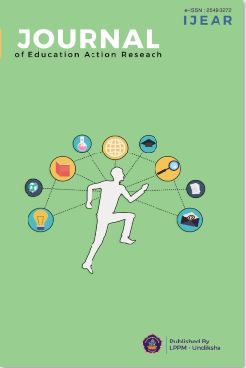Video Support in Problem-Based Learning to Facilitate of Elementary Students' Numeracy Abilities Improvement
DOI:
https://doi.org/10.23887/jear.v7i4.65589Keywords:
problem-based learning, video media, numeracy, math word problemsAbstract
The problem of this research is the low numeracy skills of the fifth grade students of elementary school. Because of that, this study aims to examine the implementation of Problem-Based Learning (PBL) with video media to improve the numeracy skills of elementary school students. The approach is qualitative with the type of classroom action research (CAR). The research subjects were 18 students and one teacher of the fifth grade of elementary school. This research was conducted in two cycles on the material for solving math word problems. Each cycle is completed in two learning meetings. Research data was obtained through observation techniques, tests, and documentation. The data analysis procedures used are condensation, data presentation, and conclusion. The results showed that the learning process using video-assisted PBL showed changes in learning focus, learning activities, engagement, interaction, and collaboration in solving problems. The students' numerical abilities category has increased from 61% of students in the high and medium categories in Cycle I to 89%.Thus, implementing the PBL learning model assisted by video media can improve the learning process and students' numeracy abilities in solving math word problems in the fifth grade of elementary school. The implication is that relevant learning media should support the PBL learning model. Implementing PBL assisted by video media needs to be used as an alternative to overcoming the problem of low students' numeracy skills in elementary schools.
References
Allen, D. E., Donham, R. S., & Bernhardt, S. A. (2011). Problem-based learning. New Directions for Teaching and Learning, 2011(128), 21–29. https://doi.org/10.1002/tl.465. DOI: https://doi.org/10.1002/tl.465
Atiqoh, C., N. (2023). Meningkatkan Kemampuan Numerasi Siswa Melalui Model Problem Based Learning Berbantu Quizizz. Jurnal Educatio, 9(1), 315. https://doi.org/10.31949/educatio.v9i1.4459. DOI: https://doi.org/10.31949/educatio.v9i1.4459
Aulia, L. N., Susilo, S., & Subali, B. (2019). Upaya Peningkatan Kemandirian Belajar Siswa dengan Model Problem Based Learning Berbantuan Media Edmodo. Jurnal Inovasi Pendidikan IPA, 5(1), 71–72. DOI: https://doi.org/10.21831/jipi.v5i1.18707
Baharuddin, M. R., Sukmawati, & Christy. (2021). Deskripsi Kemampuan Numerasi Siswa Dalam Menyelesaikan Operasi Pecahan. Pedagogy, 6(2), 10–103.
Basu Roy, R., & McMahon, G. T. (2012). Video-based cases disrupt deep critical thinking in problem-based learning: Video-based cases in problem-based learning. Medical Education, 46(4), 426–435. https://doi.org/10.1111/j.1365-2923.2011.04197.x. DOI: https://doi.org/10.1111/j.1365-2923.2011.04197.x
Catlett, C. (2020). From Article to Action: Promoting Numeracy Development. Young Exceptional Children, 23(2), 112–113. https://doi.org/10.1177/1096250620909988. DOI: https://doi.org/10.1177/1096250620909988
Chan, L. K., Patil, N. G., Chen, J. Y., Lam, J. C. M., Lau, C. S., & Ip, M. S. M. (2010). Advantages of video trigger in problem-based learning. Medical Teacher, 32(9), 760–765. https://doi.org/10.3109/01421591003686260. DOI: https://doi.org/10.3109/01421591003686260
Cheung, S. K., Dulay, K. M., Yang, X., Mohseni, F., & McBride, C. (2021). Home Literacy and Numeracy Environments in Asia. Frontiers in Psychology, 12, 578764. https://doi.org/10.3389/fpsyg.2021.578764. DOI: https://doi.org/10.3389/fpsyg.2021.578764
Cohrssen, C., & Niklas, F. (2019). Using mathematics games in preschool settings to support the development of children’s numeracy skills. International Journal of Early Years Education, 27(3), 322–339. https://doi.org/10.1080/09669760.2019.1629882. DOI: https://doi.org/10.1080/09669760.2019.1629882
Crowley, B. M. (2015). The Effects of Problem-Based Learning on Mathematics Achievement of Elementary Students Across Time [Western Kentucky Universit]. https://core.ac.uk/download/pdf/43647263.pdf.
Elliott, J. (2001). Action Research for Educational Change. Open University Press.
Kalpokaite, N., & Radivojevic, I. (2019). Demystifying Qualitative Data Analysis for Novice Qualitative Researchers. The Qualitative Report. https://doi.org/10.46743/2160-3715/2019.4120. DOI: https://doi.org/10.46743/2160-3715/2019.4120
Kay, R., & Kletskin, I. (2012). Evaluating the use of problem-based video podcasts to teach mathematics in higher education. Computers & Education, 59(2), 619–627. https://doi.org/10.1016/j.compedu.2012.03.007. DOI: https://doi.org/10.1016/j.compedu.2012.03.007
Kemmis, S., McTaggart, R., & Nixon, R. (2014). The Action Research Planner: Doing Critical Participatory Action Research. Springer Singapore. https://doi.org/10.1007/978-981-4560-67-2. DOI: https://doi.org/10.1007/978-981-4560-67-2
Kosasih. (2021). Pengembangan Bahan Ajar. Bumi Aksara.
Lajoie, S. P., Hmelo-Silver, C. E., Wiseman, J. G., Chan, L. K., Lu, J., Khurana, C., Cruz-Panesso, I., Poitras, E., & Kazemitabar, M. (2014). Using Online Digital Tools and Video to Support International Problem-Based Learning. Interdisciplinary Journal of Problem-Based Learning, 8(2). https://doi.org/10.7771/1541-5015.1412. DOI: https://doi.org/10.7771/1541-5015.1412
Loyens, S. M. M., Magda, J., & Rikers, R. M. J. P. (2008). Self-Directed Learning in Problem-Based Learning and its Relationships with Self-Regulated Learning. Educational Psychology Review, 20(4), 411–427. https://doi.org/10.1007/s10648-008-9082-7. DOI: https://doi.org/10.1007/s10648-008-9082-7
Mawarsari, N. & Krisma W., W. (2022). Pengaruh Penerapan Model Problem Based Learning terhadap Kemampuan Numerasi pada Kurikulum Merdeka Peserta Didik Kelas 1 Sekolah Dasar. Jurnal Ilmiah Ilmu Pendidikan, 5(12), 5464. DOI: https://doi.org/10.54371/jiip.v5i12.1177
Merritt, J., Lee, M. Y., Rillero, P., & Kinach, B. M. (2017). Problem-Based Learning in K–8 Mathematics and Science Education: A Literature Review. Interdisciplinary Journal of Problem-Based Learning, 11(2). https://doi.org/10.7771/1541-5015.1674. DOI: https://doi.org/10.7771/1541-5015.1674
Novitasari, R., Anggaraito, Y, U., Ngabekti, S. (2015). Efektifitas Model PBL Berbantuan Media Audiovisual terhadap Motivasi dan Hasil Belajar Siswa pada Materi Sistem Ekskresi. Unnes Jurnal Of Biology Education, 4(3), 298–301.
OECD. (2019). PISA 2018 Assessment and Analytical Framework. OECD. https://doi.org/10.1787/b25efab8-en. DOI: https://doi.org/10.1787/b25efab8-en
Purpura, D. J., & Lonigan, C. J. (2015). Early Numeracy Assessment: The Development of the Preschool Early Numeracy Scales. Early Education and Development, 26(2), 286–313. https://doi.org/10.1080/10409289.2015.991084. DOI: https://doi.org/10.1080/10409289.2015.991084
Purpura, D. J., & Napoli, A. R. (2015). Early Numeracy and Literacy: Untangling the Relation Between Specific Components. Mathematical Thinking and Learning, 17(2–3), 197–218. https://doi.org/10.1080/10986065.2015.1016817. DOI: https://doi.org/10.1080/10986065.2015.1016817
Ronis, D. L. (2007). Problem-Based Learning for Math & Science: Integrating Inquiry and the Internet (2nd ed.). SAGE Publications. https://us.sagepub.com/en-us/nam/book/problem-based-learning-math-science.
Schmidt, H. (2019). Fifty Years of Problem-based Learning. Health Professions Education, 5(1), 1–2. https://doi.org/10.1016/j.hpe.2019.01.002. DOI: https://doi.org/10.1016/j.hpe.2019.01.002
Schmidt, H. G., Rotgans, J. I., & Yew, E. H. (2011). The process of problem-based learning: What works and why: What works and why in problem-based learning. Medical Education, 45(8), 792–806. https://doi.org/10.1111/j.1365-2923.2011.04035.x. DOI: https://doi.org/10.1111/j.1365-2923.2011.04035.x
Sofyan, H., Wagiran, Kokom, K & Endri, T. (2017). Problem Based Learning Dalam Kurikulum 2013.
Sri, A. (2022). No Peningkatan Kemampuan Numerasi Melalui Problem Based Learning (PBL) Pada Siswa Kelas VI SDN Oro-Oro Ombo 02 Kota Batu.Title. Jurnal Pendidikan Taman Widya Humaniora (JPTWH), 1(3), 561.
Tout, D., Sakurai, J., & Sawatzki, C. (2021, September 13). Supporting critical numeracy and maths skills in teaching and learning. Teacher Magazine. https://www.teachermagazine.com/au_en/articles/supporting-critical-numeracy-and-maths-skills-in-teaching-and-learning.
Downloads
Published
How to Cite
Issue
Section
License
Copyright (c) 2023 Mila Qadri, Wawan Krismanto, Zaid Zainal

This work is licensed under a Creative Commons Attribution-ShareAlike 4.0 International License.












